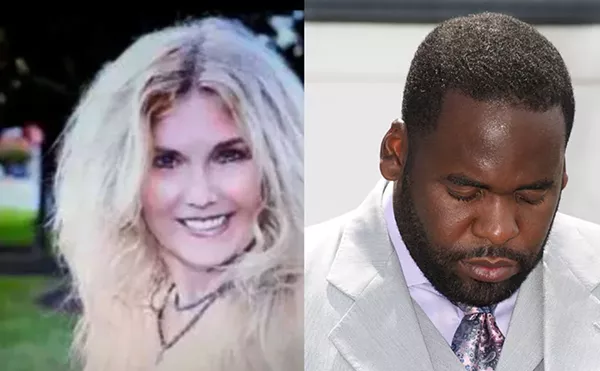
Audio By Carbonatix
[
{
"name": "GPT - Leaderboard - Inline - Content",
"component": "35519556",
"insertPoint": "5th",
"startingPoint": "3",
"requiredCountToDisplay": "3",
"maxInsertions": 100,
"adList": [
{
"adPreset": "LeaderboardInline"
}
]
}
]
Hilary Harkness: I was just in the city six weeks ago. I had just done small oil on paper drawing of a drive-in theater based on a memory of going to the drive-in as a kid in Detroit … but it was 1928 when all the old Deco buildings were there, so I really studied old pictures of Detroit.
Metro Times: How has being a young Detroit expatriate factored into your career?
Harkness: My professors used to say that it made sense that I was coming from the Midwest. I have a very nostalgic eye. I’ll like something and not know why and it’ll turn out that it’s because it reminded me of something I saw when I was a little kid. I think on some level I’m interacting with my grandparents. … I’ve been trying to rework things that interest me in relation to my family and history in general and trying to find meaning in it.
MT: It seems like it would be hard, making the paintings that you’re making, to get away from the connection to feminist history. Do you have any interest in second- or third-wave or post-feminist issues?
Harkness: I’m interested in the second wave of the ’60s and ’70s. There was some really bad all-female fiction written, in which women had superpowers because they had gotten rid of men and could blossom into this kind of fully spiritual and really hokey existence. I’m not wishing for a world without men. If the world were run by women it’d be pretty much the same. I just really like drawing women, particularly beautiful women. When I’m drawing women, I hope that they can just be read as humans. They’re virile in a way that both men and women are virile. I feel like painting is a safe playground. We’re always looking at beautiful women. I thought that I’d grow up to be a six-foot-tall blonde, and I’m not — yet somehow there’s this ideal that I can’t get away from.
MT: There have been some real criticisms — not necessarily toward your work in particular — of gratuitous nudity. Do you ever feel the need to explain why the women in your paintings are not altogether dressed?
Harkness: I’ve kind of given up on that. It either works or it doesn’t. There’s a long tradition of nude women being painted in art, and there’s also the genre of history painting that is an all-male genre depicting men doing fun things. I kind of want the best of both worlds.
MT: Given that you’re represented by one of the top galleries in the world, it seems to me that you’ve been able to forgo the status of emerging artist and jump immediately into being wildly successful.
Harkness: I feel like it’s not over yet. It’s hard for artists in their mid-30s, who have been out for a while, to keep it going. It takes a long time to develop a career. After graduating from Yale as last in my class, I got as far away as I could. I moved back to the Bay area — I had gone to school at University of California Berkeley — and after three years I realized that I was not breaking into the scene. There was no interest in my kind of painting. I was selling paintings that took me four or five months to make for $800 or $900. I realized there was no way that was going to work. I figured if I was going to fail, I had to go to New York City.
MT: So if you have to fail, you’d better fail big?
Harkness: Yes, but none of my friends had hook-ups, or at least none that they were going to share with me. I sent out slides, but that didn’t really work. So I went door to door with them and that didn’t really work either. I was getting sick of not hearing from anyone so I took two small paintings under my arms to see dealer and gallery owner Bill Maynes, and he asked me to leave one of them for the weekend to see if he could sell it. I got lucky, and one of the most important collectors in the city walked in and bought my work. I also got lucky with Jerry Saltz [art critic for the Village Voice] reviewing my debut, and again with Mary Boone. I’ve just always had the attitude that if I take care of the work, it will take care of me.
MT: Do you ever see a little Detroit in New York City?
Harkness: This is interesting. My experience of Detroit is very much tied to loving to go there because of my grandparents. It’s just as much an internal place as it is real. Nothing really ever measures up to how it looked to me as a kid. I love New York, but it will never measure up to my idealized version of Detroit. I used to love listening to my grandmother’s stories of dating my grandfather and all the things they would do in Detroit. I think a lot of artists are trying to recapture something that is gone from their lives. For me that’s what it is. The sky in New York will never look quite right to me, and every time I go back to Detroit, it’s there. Nolan Simon is spending the summer in Brooklyn and writing about art for *Metro Times*. Send comments to





